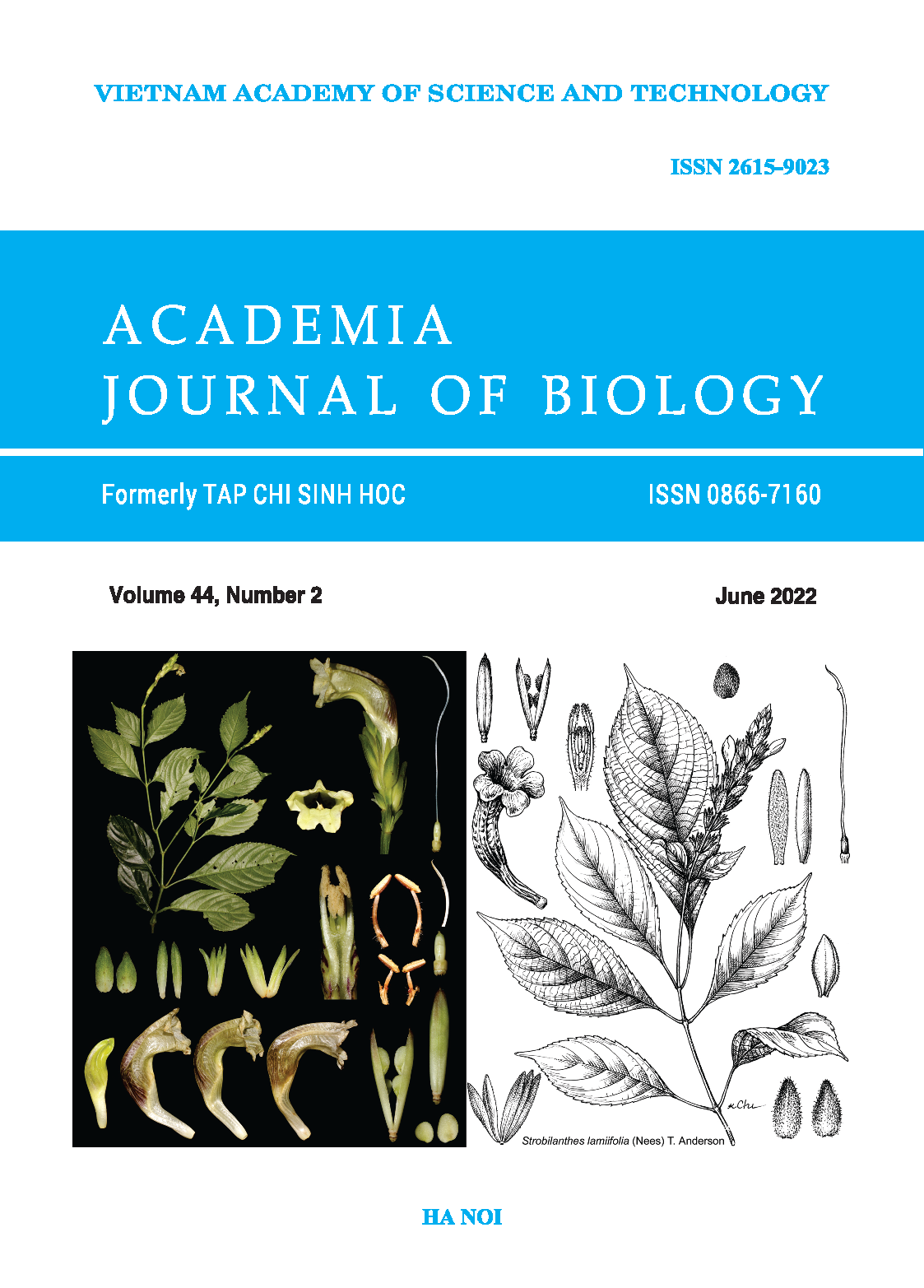Association of \(\textit{TEX15}\) rs142485241 with male infertility in 429 Vietnamese individuals
Author affiliations
DOI:
https://doi.org/10.15625/2615-9023/16820Keywords:
Male infertility, PCR-RFLP, rs142485241, TEX15, Vietnam.Abstract
Male infertility is a reproductive disease caused by various factors, including environmental factors and genetic defects. Thousands of genes have been identified to cause and associate with male infertility, such as TEX15. Our study aimed to identify the association between the polymorphism TEX15 rs142485241 and male infertility. Total DNAs were extracted from the whole blood of 429 unrelated Vietnamese individuals, including 202 healthy controls and 227 patients with male infertility. The genotypes and alleles of the polymorphism were determined by the PCR-RFLP method. The data were analyzed by statistical methods to assess the association of TEX15 rs142485241 with male infertility. The results showed that the distribution of genotypes of the polymorphism followed the Hardy-Weinberg equilibrium (p-value > 0.05). However, no association was established between the polymorphism TEX15 rs142485241 and male infertility in the three models (additive, dominant, and recessive) (p-value > 0.05). This study would contribute to the knowledge about the association of TEX15 with male infertility in the Vietnamese population.
Downloads
References
Aragon T. J., 2020. Epitools: Epidemiology Tools. https://cran.r-project.org/package=epitools
Aston K. I., Krausz C., Laface I., Ruiz-Castané E., Carrell D.T., 2010. Evaluation of 172 candidate polymorphisms for association with oligozoospermia or azoospermia in a large cohort of men of European descent. Hum. Reprod., 25: 1383–97. https://doi.org/10.1093/humrep/ deq081
Brugh V. M., Lipshultz L. I., 2004. Male factor infertility: Evaluation and management. Med. Clin. North Am., 88: 367–85. https://doi.org/10.1016/S0025-7125(03)00150-0
Colombo R., Pontoglio A., Bini M., 2017. Two novel TEX15 mutations in a family with nonobstructive azoospermia. Gynecol. Obstet. Invest., 82: 283–286. https://doi.org/10.1159/000468934
Dam A. H. D. M., Koscinski I., Kremer J. A. M., Moutou C., Jaeger A. S., Oudakker A. R., Tournaye H., Charlet N., Lagier-Tourenne C., Van Bokhoven H., Viville S., 2007. Homozygous mutation in SPATA16 is associated with male infertility in human globozoospermia. Am. J. Hum. Genet., 81: 813–820. https://doi.org/10.1086/521314
Graffelman J., 2015. Exploring diallelic genetic markers: The HardyWeinberg package. J. Stat. Softw., 64: 1–23. https://doi.org/10.18637/jss.v064.i03.
Hirsh A., 2003. Male subfertility. BMJ, 327: 669–72. https://doi.org/10.1136/bmj.327. 7416.669
Ben Khelifa M., Coutton C., Zouari R., Karaouzène T., Rendu J., Bidart M., Yassine S., Pierre V., Delaroche J., Hennebicq S., Grunwald D., Escalier D., Pernet-Gallay K., Jouk P. S., Thierry-Mieg N., Touré A., Arnoult C., Ray P. F., 2014. Mutations in DNAH1, which encodes an inner arm heavy chain dynein, lead to male infertility from multiple morphological abnormalities of the sperm flagella. Am. J. Hum. Genet., 94: 95–104. https://doi.org/10.1016/j.ajhg.2013.11.017
Koscinski I., Elinati E., Fossard C., Redin C., Muller J., Velez De La Calle J., Schmitt F., Ben Khelifa M., Ray P., Kilani Z., Barratt C. L. R., Viville S., 2011. DPY19L2 deletion as a major cause of globozoospermia. Am. J. Hum. Genet., 88: 344–350. https://doi.org/10.1016/j.ajhg. 2011.01.018
Matzuk M. M., Lamb D. J., 2008. The biology of infertility: Research advances and clinical challenges. Nat. Med., 14: 1197–213. https://doi.org/10.1038/nm.f.1895
Okutman O., Muller J., Baert Y., Serdarogullari M., Gultomruk M., Piton A., Rombaut C., Benkhalifa M., Teletin M., Skory V., Bakircioglu E., Goossens E., Bahceci M., Viville S., 2015. Exome sequencing reveals a nonsense mutation in TEX15 causing spermatogenic failure in a Turkish family. Hum. Mol. Genet., 24: 5581–5588. https://doi.org/ 10.1093/hmg/ddv290
Plaseski T., Noveski P., Popeska Z., Efremov G. D., Plaseska-Karanfilska D., 2012. Association study of single-nucleotide polymorphisms in FASLG, JMJDIA, LOC203413, TEX15, BRDT, OR2W3, INSR, and TAS2R38 genes with male infertility. J. Androl., 33: 675–83. doi: 10.2164/jandrol.111.013995
R Core Team, 2020. R: A language and environment for statistical computing. Available at https://www.r-project.org/ https://www.r-project.org/
Ruan J., He X. J., Du W. D., Chen G., Zhou Y., Xu S., Zuo X. B., Fang L. Bin, Cao Y. X., Zhang X. J., 2012. Genetic variants in TEX15 gene conferred susceptibility to spermatogenic failure in the Chinese Han population. Reprod. Sci., 19: 1190–6. https://doi.org/10.1177/1933719112446076
Wang P. J., McCarrey J. R., Yang F., Page D. C., 2001. An abundance of X-linked genes expressed in spermatogonia. Nat. Genet., 27: 422–6. https://doi.org/10.1038/86927.
Wang P. J., Page D. C., McCarrey J. R., 2005. Differential expression of sex-linked and autosomal germ-cell-specific genes during spermatogenesis in the mouse. Hum. Mol. Genet., 14: 2911–8. https://doi.org/ 10.1093/hmg/ddi322
Yang F., Eckardt S., Leu N. A., McLaughlin K. J., Wang P. J., 2008. Mouse TEX15 is essential for DNA double-strand break repair and chromosomal synapsis during male meiosis. J. Cell Biol., 180: 673–679. https://doi.org/10.1083/jcb.200709057
Zhou Y., Qin D., Tang A., Zhou D., Qin J., Yan B., Diao R., Jiang Z., Cai Z., Gui Y., 2009. Developmental expression pattern of a novel gene, TSG23/Tsg23, suggests a role in spermatogenesis. Mol. Hum. Reprod., 15: 223–30. https://doi.org/ 10.1093/molehr/gap015
Downloads
Published
How to Cite
Issue
Section
License
Academia Journal of Biology (AJB) is an open-access and peer-reviewed journal. The articles published in the AJB are licensed under a Creative Commons Attribution-NonCommercial-NoDerivatives 4.0 International License (CC BY-NC-ND 4.0), which permits for immediate free access to the articles to read, download, copy, non-commercial use, distribution and reproduction in any medium, provided the work is properly cited (with a link to the formal publication through the relevant DOI), and without subscription charges or registration barriers. The full details of the CC BY-NC-ND 4.0 License are available at https://creativecommons.org/licenses/by-nc-nd/4.0/.












